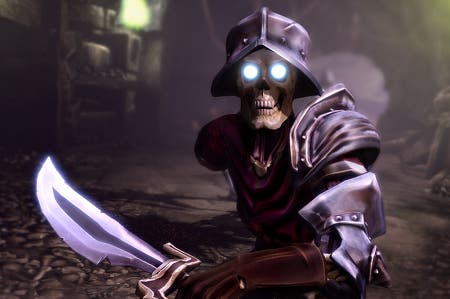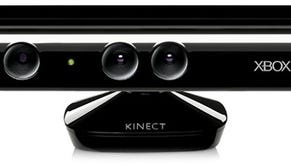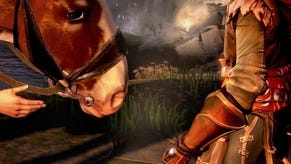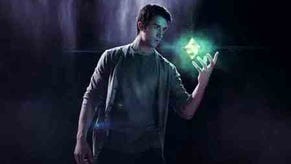Kinect's Journey
Can Fable: The Journey, Kinect's biggest game yet, usher in a new era for Microsoft's motion controller? "It was never going to be easy," Lionhead tells us.
Fable: The Journey is, without a doubt, the biggest and most ambitious game yet for Kinect. It's no aerobic festival of mini-games but a full-length action-adventure with epic narrative aspirations, played from the comfort of your couch. It has lavish production values: beautiful graphics, superb animation, fine voice-acting and a musical score that tracks the action from moment to moment, like a movie's.
Play The Journey for an hour or so, as I did last week, and you can see the quality and effort sweating from the screen. Microsoft has brought the full weight of one of its most talented studios, Lionhead, to bear on this project; Mark Webley, studio head since Peter Molyneux's departure, tells me that virtually the entire 150-strong staff is currently at work on it. Forget the gaudy distraction of Kinect Star Wars. Microsoft clearly intends The Journey to be a grand entertainment and a watershed release for its motion sensor.
But if you're the average Eurogamer reader, you probably don't want to play it - or think you don't.

Kinect has been a huge sales hit for Microsoft, but as it approaches its second anniversary, it's still unproven where it counts. It's finicky to use. Countless attempts to shoehorn support into mainstream games, from Skyrim's shouts to Ghost Recon: Future Soldier's weird gun-massage, have left gamers unconvinced. And Kinect-exclusive games - even good ones like Kinect Sports and Dance Central - have so far only splashed around in the shallow end of casual gaming. Fun for all the family! Fun for five minutes.
Well, the least you can say of Fable: The Journey is that it's fun for longer than that. It's designed to be played for long sessions, and played seated, using technology that Lionhead has spent years working on and that will now filter through into Microsoft's official developer support for the device. The effect cannot be understated; it's actually relaxing to play.
"Play The Journey for an hour or so, as I did last week, and you can see the quality and effort sweating from the screen."
During my hour of play I am introduced to the game's hero, a young working lad called Gabriel driving his caravan in convoy through Fable's bucolic, Dickensian fantasy world. He gets separated from the convoy and meets a mysterious woman that Fable fans will recognise as Theresa. After they flee together from a mysterious devouring force, she introduces him to some magical gauntlets that allow him to wield spells in combat, and he fights his way through a bug-infested cave.
So I learn to master the reins of his horse and some of those spells: an offensive bolt shot by the right hand, a telekinetic tether on the left that can push enemies away and yank scenery too and fro, a shield employed by raising your arm in a watch-checking motion. It's immediately obvious that a great deal of thought has gone into the game's controls and interface.
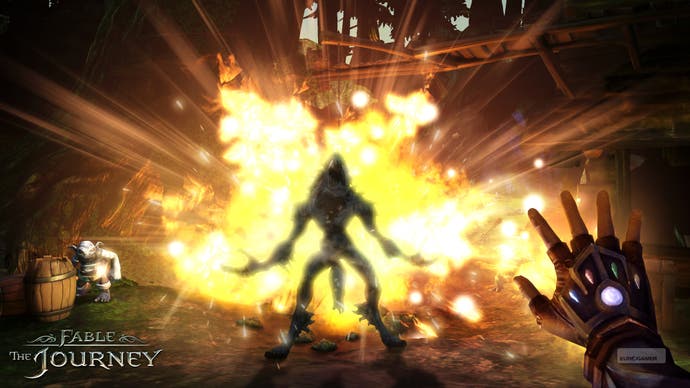
The attention that's been paid to feedback, always a woolly weakness of Kinect games, is particularly noticeable. An on-screen read-out of your posture combines with strong audiovisual cues to ensure you always have a pretty good idea of Kinect's read on you. Aiming is surprisingly accurate (at least with your dominant hand - control customisation will be included for left-handed players); zapping an enemy with a bolt is a simple matter of punching directly toward its image on the screen.
It's all so well thought-out. Movement in combat has been restricted to strafing between three lanes with a leaning motion, rather than allowing free movement, and the first-person camera tracks your body movements beautifully. The on-rails levels have been carefully paced to ensure moments of frenzied action flow smoothly into calmer sections or well-directed cut-scenes that let you give your arms a rest.
"It feels like a film when you play it, an interactive film... It's a road movie. It's a fantasy road movie," - Gary Carr, creative director.
As smart as the design is, the technology still lets it down. When it works, it works very well, but Kinect's read on me is erratic during combat, and the cart's steering is vague. It's a reminder that if Fable: The Journey is ambitious, the technology of Kinect itself is more ambitious still. Has Lionhead's attempt to usher Kinect games into a new era come too early?
The Journey's creative director Gary Carr came to the Fable team from Lionhead's Kinect R&D team - which created the infamous Milo & Kate demo (or was it?) - and he's very clear on the issue. Kinect is advanced technology at an early stage in its development, it has bugs, and it's up to Lionhead and other leading developers to fix them.
Part of the problem is that bringing a player and Kinect game together involves a two-way teaching process. You have to teach players what sort of actions you want them to make and work around their expatiations (some players might imagine spellcasting as a Harry Potter flick of the wand, whereas in The Journey it's a Yoda-style force push). And you have to teach Kinect to register those actions properly across a huge range of body types and gestures. Both of these take extensive testing.
"We keep sampling and machine learning from everybody," says Carr. "This is a challenge you've got with any game on Kinect, you really can't second guess what people are going to do. But that's our job and we'll do that. We consider them bugs... We just need to debug those issues, that's part of the job."
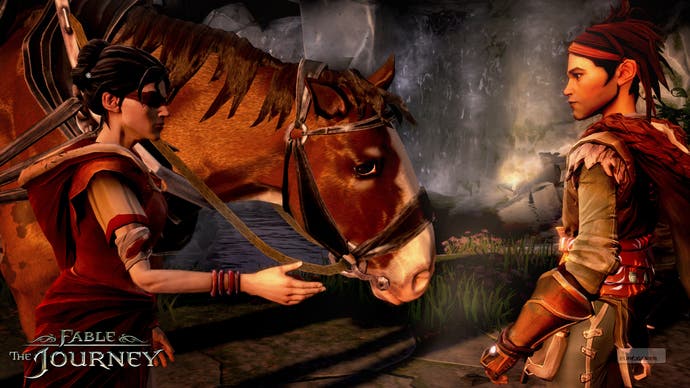
Carr, a 30-year veteran of UK development who came to Lionhead with Molyneux and Webley from Bullfrog, has the luxury of the longest possible view on Kinect's growing pains. "I'm old enough to have worked on text adventures in the early '80s. I worked through when that thing called a joystick came along, which we thought was just heresy, and and then a mouse and then [a gamepad] and then a motion controller... It's our job to make it as fun for you, and we just see that as the challenge we've got to solve."
But "this is a bigger jump", he concedes. "I think it was very brave of Alex Kipman and Kudo [Tsunoda] and those guys who launched Kinect. It's a step change, for sure. It's different from anything that's gone before... I think developers just need to work that bit harder and take that bit longer. Which means it's a slow-moving ball, but it's going to build momentum I think as more stuff gets solved, like seated play."
"Moving Kinect games past casual novelty is going to involve breaking down barriers of both technology and audience perception, and Carr admits that it's not going to be easy."
Also, it's fair to say that times have changed. Consumers' tolerance of flaws in new technology is not what it was in the days of tape-loaded home computer games played on rubber keyboards. And expectations are very quickly and clearly defined: this is a casual motion-control game, and it's not for me. It's, you know, for kids.
But Carr is adamant that developers need to move beyond that mindset - or ignore it completely - if Kinect is to reach its true potential. "It's weird - 10, 15 years ago we made games with no idea who we were making them for. We didn't get put into these hyper-socials and blah blah blah, it's all gobbledygook to me to be honest. We just made a game," he says, recalling the scepticism which initially greeted Bullfrog's Theme Hospital - and the seven million sales that followed.
"In those days, nobody told you what to make and who to make it for, and I try to keep that in me. I think if there's a demographic out there, I try to blinker myself. I get spreadsheets sent to me all the time and I just pretend to read them. I think, as designers, you should try not to be too polluted by this information."
So Lionhead has dared to do what no-one else has to date: make a full-scale adventure for Kinect and adapt the technology to the game, not the other way around. It hasn't just been a technical learning experience for the studio, which has traditionally made much more player-led games than The Journey's strongly directed experience. The Journey has (or rather, is) a "story mode much longer than any Fable". "We needed to make a substantial game and we've done that," Carr says. "It feels like a film when you play it, an interactive film. Characters come in, they move on. It's a road movie. It's a fantasy road movie."
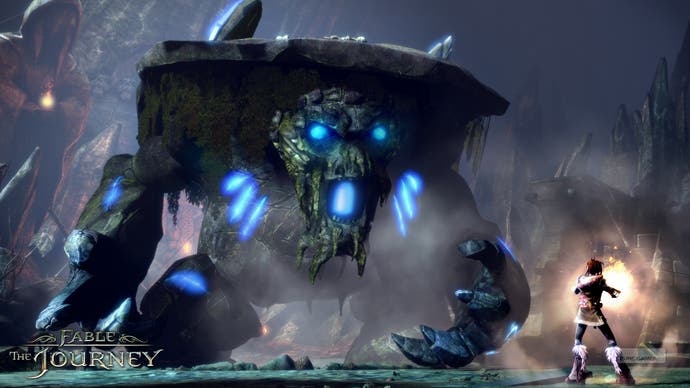
The game certainly has that atmosphere, and it's easy to imagine a family gathering on the sofa to play it together, the way they might to watch a box set of Lord of the Rings DVDs. That's a new kind of entertainment for Kinect to be offering, but to Carr's mind - and, you imagine, the mind of some Microsoft strategist somewhere - it's as vital a part of the future of the device as fitness and dancing games. But moving Kinect games past casual novelty is going to involve breaking down barriers of both technology and audience perception, and Carr admits that it's not going to be easy.
"I just think we need to break through that seal of solving some of those issues to make those diverse games - that's an honest answer," he says. "I think it's been our challenge at Lionhead since November 2008, when we first got our kit. It was never going to be a knock-it-out-the-park, easy thing to sort out on day one. It was always going to be a challenge. But I think more and more developers will start to piece things together, and then there'll be a killer game, and then the floodgates will open."
For now, though, the UK studio is leading the charge without a frame of reference. "Even though we're second-generation Kinect development here, I still feel we're like the pioneers on the beach, especially with the area we're going down. We are kind of in a club of one at the moment. That's our job. We're first party, Microsoft bought us as an innovational company, to lay those foundations."
It's too early to say whether or not The Journey will be the title to move Kinect games into uncharted territory, or to advance Kinect's reputation from novel gadget to entertainment platform in its own right. Lionhead's commitment to those causes in Fable: The Journey - especially in establishing a solid framework for seated play, and in expanding the horizons of Kinect game production - is both substantial and impressive. But, Carr, admits, the Guildford outfit can't do it alone.
"[Kinect] isn't actually as much of a gimmick as I think it's been labelled with. It just needs a lot more effort from the industry and developers to actually utilise it... The will has to come from the industry to make it happen."
